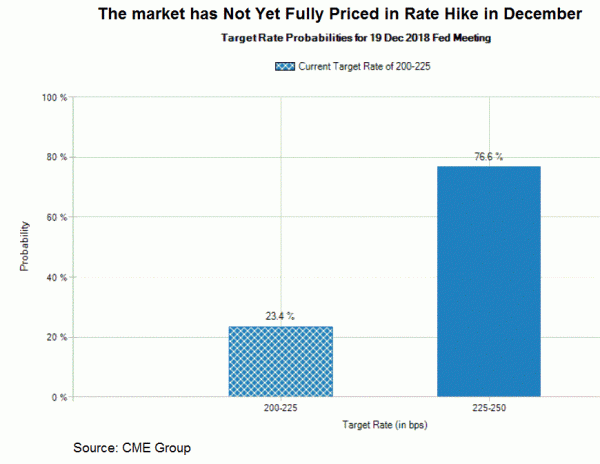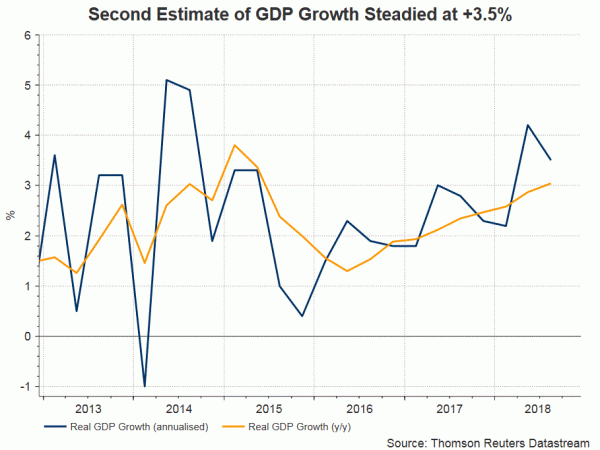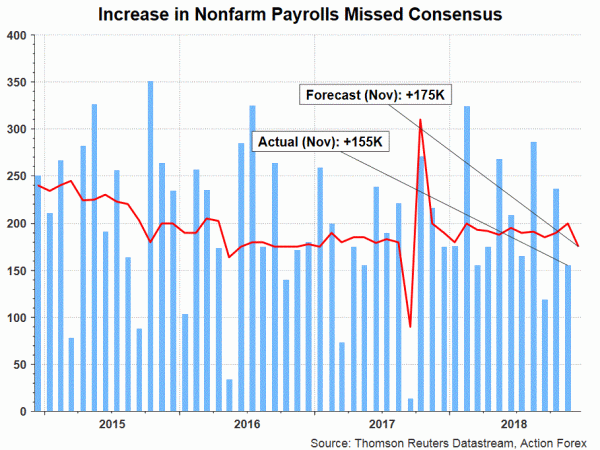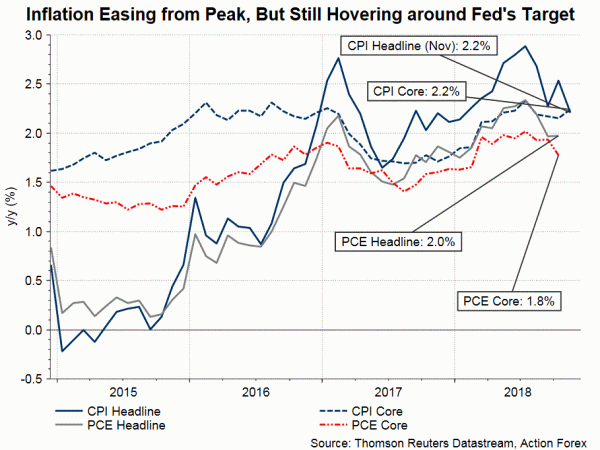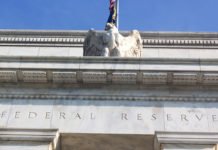While the majority of market participants (including us) expects the Fed to raise the policy rate, by +25 bps, to 2.25-2.5% at the December meeting, this is far from fully priced in. CME’s Fed funds futures suggest that the market has priced in less than 80% of a rate hike this week. The possible downside surprise is due to recent slowdown in macroeconomic data, stock market turmoil and ongoing uncertainty in US-China trade war.
The upcoming meeting is an important one. Besides announcement of the rate decision, the Fed would communicate its outlook on the future interest rate path, release the latest median dot plots and the updated economic projections. We expect dovish tone from the central bank, as indicated by Fed Chair Jerome Powell’s recent comments about neutral rates. We expect the latest dot plots to reveal two more rate hikes in 2019, down from three in September. Meanwhile, the staff would likely downgrade the GDP growth and inflation forecasts.
US economy has remained strong. Yet, signs of fatigue have emerged in recent data flow. The second estimate shows that GDP growth was unrevised at +3.5% q/q (annualized) in 3Q18. While marking a slowdown from second quarter’s +4.2%, the growth is still robust, thanks to the aggressive tax reform. Yet, as the impact of fiscal stimulus fades, growth would decelerate more significantly in the final quarter of this year and in 2019.
We have already started seeing moderation in several indicators for the fourth quarter. Nonfarm payrolls increased +155K in November, compared with consensus additions of +200K and October’s +237K. The unemployment rate steadied at decades’ low of 3.7%. Average earnings soared +3.1% y/y in December, in line with expectations. Robust wage growth signals the job market is still resilient and the lower-than-expected payroll increase is not too worrisome. Fewer vacancies and higher wage growth are features of an economy at (or beyond) full employment.
Inflation eased in November, Headline CPI moderated to 2.2% y/y from October’s 2.5%. Yet this had been anticipated by the market. Core CPI edged higher, by +0.1 percentage point, to +2.2% last month. Concerning Fed’s preferred gauge of inflation, PCE steadied at +2% in October, while core PCE slid -0.1 percentage point to +1.8% for the month.
Markit’s manufacturing PMI eased to 53.9 in December, from 55.3 a month ago. The market had anticipated moderation to 55.1. The services PMI also slowed to 53.4, from November’s 54.7. The market had anticipated a flat reading. New home sales slumped -8.9% to 554K units, lower level in more than 2.5 years, in October. Meanwhile, the median new house price in dropped -3.1% y/y to $309,700 in the month. The effect of rate hikes has becoming more evident in the market.
Resilient employment market and inflation hovering at +2% support the Fed to adopt another rate hike in December. Indeed, the November minutes also noted that a rate hike would come “fairly soon”.
The path in 2019 is more uncertain, though. The market was surprised by Powell’s abrupt shift in monetary stance as he noted that “interest rates… remain just below…neutral”. This has led many to expect an end of the current tightening cycle relatively soon. The November minutes, also reveal that the members debated on the change in forward guidance regarding the pledge on “further gradual increases” in the policy rate.
We expect some adjustments to be seen in this regards. The members might simple remove the forward guidance, or change it so as to stress the importance of “data-dependence” on future rate decision. The overall tone of the accompanying should be more dovish, cautioning the slowdowns in the global economy and the volatility in the stock markets. US- China trade war would remain under the spotlight. Although Trump has agreed to postpone raising trade tariff on Chinese products, the conflict has far from being resolved.
In September, the median dot plot shows that the policy rate would increase to 3.125% in 2019 and then to 3.375 in 2020 and 2021. We only need two staff expecting lower rates (each by 25 bps) in the 2019 to change the dot plot to two rate hike from September’s three. Indeed, the market is now expecting two rate hikes next year, while some expect none.




